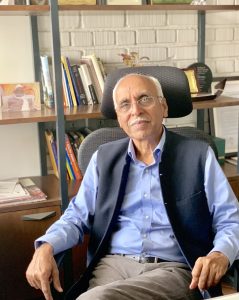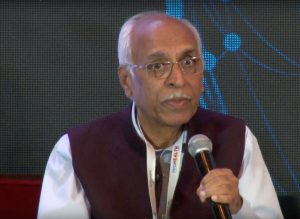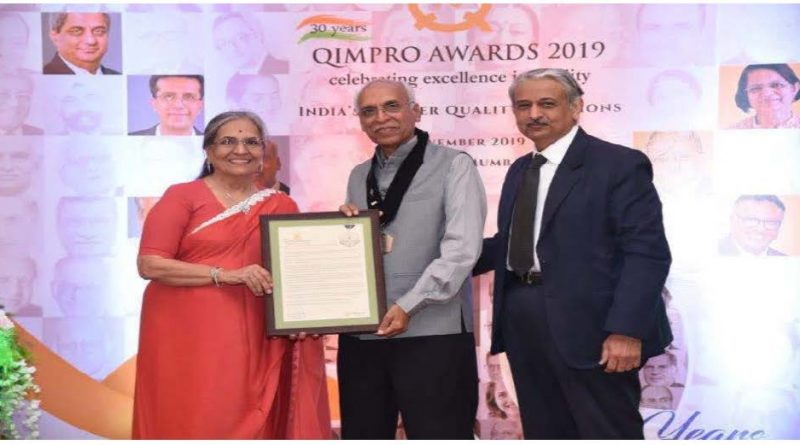Coping with twin Challenges

Medical professionals need to adhere to patient safety guidelines, improve on communication with patients and adopt efficient work processes. Equally important is to work towards reducing the spiralling cost of hi-tech medical care in a developing country like India….
By Dr Vijay Agarwal
With the passage of time, healthcare as component of overall wellbeing is seen as basic obligation to be met by the governments. In order to meet such an obligation, governments need to raise spending on healthcare as percentage of GDP which again is not an easy task for developing economies like India, which have other basic priorities including education, environment, infrastructure, electricity, roads etc. The only way out is to incentivize private health sector to invest in healthcare infrastructure and regulate the same for quality and patient safety. Equally important is to apply management tools to help in improving of operational efficiency and cutting down of wasteful work processes and thereby reducing the operational cost. These measures will surely help hospitals in achieving high patient safety at low cost.
Healthcare delivery today has become very complex. Earlier it was considered to be safe and inexpensive, less invasive and under the comforting personal care of a family physician; while in present times it is viewed as potentially dangerous, expensive and driven primarily by technology & medical consultants.
Rationale behind this change has been ill understood both by the community and the healthcare providers and therefore they are inadequately prepared to deal with unforeseen outcomes including medical errors and cost. We need to look at the journey of increasing reporting of medical errors, medicine becoming hi-tech and expensive and how the medical community can cope with this change.
History of Medical Errors
The fact that medical errors have become the 3rd leading cause of death in a developed country like USA is a pointer to the possible scenarios around the world especially in developing countries including India. Hippocrates recognized that harm could arise from the well-intentioned actions of healers. Thus, the Hippocratic Oath makes physicians pledge to “prescribe regimens for the good of my patients according to my ability and my judgment and never do harm to anyone.” Since then, primum non nocere (“FIRST DO NO HARM”) has become a central tenet for contemporary medicine.
Till the late 19th Century, data on adverse outcomes were hard to come by and were mostly anecdotal, making most physicians and hospital administrators ignore medical errors as aberrations and they were being noticed only when law suits were filed. It is with the advent of news channels and other communication media that medical services started coming under a scanner of the common people who realized that the delivery of medical services were not without real risk. The health reporter for the Boston Globe, Betsy Lehman, died from an overdose during chemotherapy. Famous film star Sri Devi’s mother Rajeshwari was operated on the wrong side of brain with disastrous consequences. Josie King was an 18-month old baby when she died due to medical negligence in one of the best hospitals in USA. Since then, her mother Sorrel King went on to become a champion to promote patient safety. In April 1982, the public and the medical fraternity was shocked by the ABC television program 20/20 entitled The Deep Sleep; the producers stated that, every year, 6,000 Americans die or suffer brain damage related to anesthetic mishaps.
One of the milestones to highlight that medical errors were not anecdotal but a regular feature even in the best of the hospitals was the famous article “ To Err is Human” published by Institute of Medicine (IoM) in the year 2000. The study estimated that as many as 98,000 people die in any given year from medical errors that occur in hospitals (USA alone) – more than the number of deaths from motor vehicle accidents, breast cancer, or AIDS – three causes that receive far more public attention. A 2006 follow-up to the IoM study found that medication errors were among the most common medical mistakes, harming at least 1.5 million people every year.
Since then medical errors have come under greater scrutiny. A study in 2016 declared medical errors to be the 3rd leading cause of death in USA. Recognizing that healthcare errors impact 1 in every 10 patients around the world, the World Health Organization (WHO) recognized patient safety as an endemic issue of concern.
Although we have poor structured documentation of medical errors in India, the incidence of medical errors in India will be manifold higher. Example of surveillance data of Hospital Associated Infections (HAI) published by Dr Victor Rosenthal and Indian co-authors from 20 cities of India, collected from 2004 to 2013, from 236,700 ICU patients for 970,713 bed-days can be an eye opener. Authors found 5.1 central line-associated bloodstream infections (CLABSIs) per 1,000 central line-days (5 times above USA), 9.4 cases of ventilator-associated pneumonia (VAPs) per 1,000 mechanical ventilator-days (9 times above USA), and 2.1 catheter-associated urinary tract infections per 1,000 urinary catheter-days (2 times above USA). Furthermore, the burden of HAI was also reflected in higher mortality rates, hospital costs, because of prolonged length of stay (LOS), use of extra beds, and higher antimicrobial resistance.
Medical Errors and Increasing Cost
Medical errors and resulting complications have surely increased the cost of providing medical care. However, to quantify the degree to which the medical errors contribute to the increasing cost is not easy. The Society of Actuaries Health Section sponsored a study to measure the annual frequency of medical errors in the United States and the total measurable cost to the United States economy of these errors. This effort was based upon an analysis of an extensive claim database, and it therefore relied upon medical events, which had been submitted for payment by medical providers.
Key findings from the study included:
There were 6.3 million measurable medical injuries in the U.S. in 2008; of the 6.3 million injuries, the authors estimate that 1.5 million were associated with a medical error.
The average total cost per error was approximately $13,000.
In an inpatient setting, seven percent of admissions are estimated to result in some type of medical injury.
The measurable medical errors resulted in more than 2,500 avoidable deaths and more than 10 million excess days missed from work due to short-term disability. This number includes only the errors that researchers could identify through claims data, so the total economic impact of medical errors was in fact greater than what was reported.
The relationship of the medical errors to the cost was taken to another level when medical profession came under attack for the fee-for-service system. It has been alleged that doctors and hospitals fared better financially when patients needed follow-up care after an error occurred. The viewpoint is that for every complication arising out of an error, doctors and hospitals perform some additional services, for which they will receive additional payments. While a hospital’s leadership consciously will not hurt patients to make more money, but the system does not encourage and reward better and more efficient care.
Some of the steps taken in a country like USA are an indication of things to change. Recent national health reform legislation (the Patient Protection and Accountable Care Act or PPACA) has several quality improvement provisions including restructuring the way healthcare is delivered in the United States through accountable care organizations (ACOs) and value-based purchasing. The Centers for Medicare & Medicaid Services (CMS) has for the first time said it will stop reimbursing hospitals for two major problems that cost the government and by extension taxpayers, billions of dollars; (1) preventable readmissions and (2) healthcare facility–acquired conditions, such as infections.
A big causality of this emerging scenario even in India has been the erosion of the trust that medicos enjoyed in the community. It has been a drastic change for a country where doctors were worshipped; people have begun to believe that doctors have become greedy and the hospitals have become commercial.
Private healthcare is the dominant healthcare provider in India now as Government spending on health has been less than 1% of GDP for years leading to the consequential growth of private healthcare. The huge demand created by the increasing middle class and development in the medical sector paved the way for for-profit hospitals in the 1990s. This helped in augmenting the availability of super-specialty services across the country.
The advent of these super-specialty corporate hospitals exposed the community to effective but expensive, yet error prone healthcare delivery. A study done by IIMA (Indian Institute of Management Ahmedabad) based on financial statement data of private hospitals for the years 1999 to 2004 concluded that the financial risk in this sector is high because of lower profitability and lower operating efficiencies. Medical establishments are hugely capital intensive with very poor ROI. Many hospitals are running in losses. Although, international patients find hospitals in India to be good and inexpensive, yet they are considered very expensive by the local population in India. Reasons for this could be:
Most people have not planned expenditure on healthcare. Low penetration of health insurance needs to be addressed to meet the high unexpected expense for high-end medical care.
Community has no knowledge of the real expense involved in running a hospital because the Government-run facilities are providing “free” care to them. However, these facilities are not free and are primarily run by taxpayers’ money. A costing exercise of the not-for-profit quality institutions needs to be done to make people aware about the actual cots.
Financial burden of healthcare on the family has increased because of increased life expectancy with the elderly in the family requiring more medical attention.

Need For Change:
Highlighting of medical errors by media and violence faced by medical profession, has pushed the case for need for medical professionals to make a sincere attempt to adhere to patient safety guidelines, improve on communication with patients and adopt efficient work processes. Patient safety has emerged as a distinct healthcare discipline supported by a developing scientific framework. There is a significant trans-disciplinary body of theoretical and research literature that informs the science of patient safety.
The resulting patient safety knowledge continually informs improvement efforts such as: applying lessons learned from business and industry, adopting innovative technologies, educating providers and consumers, enhancing error reporting systems, and developing new economic incentives.
Yet despite best efforts, the results of patient safety initiatives have been far from satisfactory. It is suggested that professional bodies work on twin challenges i.e. patient safety and affordability by organizing research and dissemination through workshops and seminars. In 1983, the British Royal Society of Medicine and the Harvard Medical School jointly sponsored a symposium on anesthesia deaths and injuries, resulting in an agreement to share statistics and to conduct studies. By 1984, the American Society of Anesthesiologists (ASA) had established the Anesthesia Patient Safety Foundation (APSF). Anesthesia related deaths have surely decreased significantly over a period of time. A similar effort of AHPI and CAHO to involve ISRO to evolve guidelines for Emergency and Critical Care has been a step in this direction.
Unfortunately, these efforts are too small considering the complexity of healthcare delivery setting with multiple types of work, many different professions and varying working conditions across clinical environments. Areas like pharmacy, radiotherapy, nuclear medicine and blood bank require different inputs as these are highly standardized and rely on automation and information technology. They are islands of reliability within the much more chaotic wider hospital environment.
In healthcare we have to adapt our approach to safety according to the nature of the work, the working conditions and use a variety of underlying models of safety.
 Scaling Heights of Glory
Scaling Heights of Glory
Dr Vijay Agarwal, President, Consortium of Accredited Healthcare Organizations, was awarded the “QIMPRO PLATINUM STANDARD” Award 2019 for HEALTHCARE by Qimpro Foundation on 13th November, 2019 at Mumbai. Qimpro Awards was conceptualized in 1989 by Dr J. M. Juran, the Quality Guru, to recognize individual excellence in quality management. The awards were commenced by recognizing leaders and facilitators in business with the Qimpro Gold Standard and Qimpro Silver Standard respectively in four categories – Education, Healthcare, Business, and Environment.
A Qimpro Platinum Standard awardee is the one who is a national statesman for quality & excellence, with global footprints. Dr Vijay, a national crusader for continual Quality Improvement in Healthcare, has a vision to raise the bar of Indian healthcare organizations to match global standards, through CAHO which is a platform created for NABH/NABL/JCI accredited HCOs to share best practices, create benchmarks and training programs. Apart from facilitating continual quality improvement in these HCOs, CAHO encourages these organizations to handhold and mentor other hospitals to join quality journey and accreditation.
Dr Agarwal believes that ‘People Make Quality.’ Driven by this passionate belief, he has established a series of CAHO Certified Professional Courses to equip and train every healthcare professional to pursue the quality journey. Dr Agarwal is a post-graduate in paediatrics from the Maulana Azad Medical College, New Delhi.
He commenced his professional career in 1973 and has over the decades earned a sterling reputation as a Paediatrician. He will be remembered for his role in bringing Pulse Polio strategy to the country and for his strategic skills demonstrated while driving the National Pulse Polio Program. Dr Agarwal was a Member of the ISRO Health Quest Project, a unique collaboration between space scientists and healthcare professionals to take the country closer to the goal of “error-free” healthcare.
Accreditation Initiatives:
One of the major routes for propelling healthcare providers to become safer was to encourage hospitals to follow standards (SOPs) and other national and international guidelines. A standard is a statement that defines the structures and processes that must be substantially in place in an organization to enhance the quality of care. Accreditation is an external review of quality with four principal components:
Bodies like NABH have been able to sensitize hospitals in India about the need for accreditation. Many government health insurance schemes have begun empanelment of hospitals on the basis of NABH accreditation. This has increased push for more and more hospitals going for accreditation. However, this has also created tendency in obtaining accreditation certificate through short cuts rather than working in spirit of patient safety. Studies are needed to document the impact of accreditation on quality/patient safety. Most hospitals feel that getting accreditation is the final destination of their quality journey while actually it should be the beginning.
Upholding Safe, Affordable & Quality Healthcare
Dr Vijay Agarwal graduated in 1968 and obtained post-graduation in Paediatrics from the prestigious Maulana Azad Medical College, New Delhi in 1973.
Over the last four decades, besides being a paediatrician of repute, he has played a key role in improving the state of healthcare in India. He made great impact on success of national programmes such as Pulse Polio Programme and Centralized Waste Management Scheme in Delhi. He continues to leverage his expertise as an excellent organizer, strategist & administratorand is presently championing the cause of patient safety and enhancing quality in healthcare delivery.
Current Responsibilities:
President of Consortium of Accredited Healthcare Organizations (CAHO).
Key Achievements:
Under the umbrella of CAHO, conceived the idea of training quality implementers in the country. Already, more than 1000 professionals have been trained in the basic programme approved by NABH/NBQP. The advanced programme has been approved by HSSC (Health Sector Skill Council) and has 200 plus professionals trained till date.
- Key Organiser CAHOCON 2016, 2017, 2018 and 2019 – an event that has become a milestone for NABH and NABL accredited hospitals.
- Co- Chair of Accreditation Committee of NABH (2015 to 2018)
- Director Operations and Administration in Max Healthcare (2003 to 2007): Was responsible for setting up their flagship hospitals at Saket New Delhi.
- Executive Director (2007-2015) of Pushpanjali Crosslay Hospital, Ghaziabad: Was responsible for setting up a world-class institution. He hired visually and hearing handicapped persons and demonstrated that they can work as efficiently as the normal people.
- Advisor to Max Healthcare for Quality & Business Excellence (July 2015 to July 2019)
- Member – Government of Karnataka Committee (2016-2017): Involved in procedural costing of 25 common procedures in collaboration with IIM Bangalore, NABH and other stakeholders
- Chair of Technical Committee of Karnataka Taskforce (2016-2017) for recommending public policy in healthcare.
- Member- Health Quest-a project of ISRO along with AHPI, CAHO, SEMI, ISCC): Developed guidelines for emergency and critical care to minimize adverse events in these high-risk areas.
- Founder Chairman of Nursing Home Forum of Delhi Medical Association from 1992 to 2002. During this period, worked towards giving direction to biomedical waste rules and helped in creating the centralized waste management facilities
- Member of the Immunization Advisory Committee of IAP that was responsible for advocating Pulse Polio Strategy and then was a lead member of the core committee to implement Pulse Polio Program with Dr Harshvardhan (Minister of Health, Govt. of Delhi)
- Assisted Siddharth Aggarwal, Amicus Curiae appointed by High Court Delhi, to suggest steps to tackle violence against doctors.
- Founder President of Society for Child Development: The society works towards vocational training of mentally challenged children all over the country.
- Hony. Professor, College of General Practitioners, Indian Medical Association and author of many books and articles.
- Recipient of Distinguished Alumnus Award of Maulana Azad Medical College
- Lifetime Achievement Award of Indian Medical Association.
- Has been conferred Qimpro’s Platinum Award for Healthcare 2019
One of the reasons for this has been the fact that clinicians have kept themselves away from learning and adopting the rapid development in the field of hospital quality. It is also the inability of the clinician to comprehend that delivery of healthcare service is now teamwork. Clinicians are rather reluctant to learn from quality managers who have emerged as “specialists” in quality having learnt all the Standards and SOPs. Most of the times, the quality managers are much junior in hierarchical set-up of the hospital. They are not able to establish a rapport with the senior clinicians who consider quality documentation to be a roadblock in the clinical work. The senior administrators are focused on the balance-sheet and find quality issues raised by the quality manager as necessary evil. Quality implementation can happen only with the active involvement of all the stakeholders. The SOPs and guidelines have to be owned by all the members of a department/ hospital.
Conclusion:
With the passage of time, healthcare as component of overall wellbeing is seen as basic obligation to be met by the governments. In order to meet such an obligation, governments need to raise spending on healthcare as percentage of GDP which again is not an easy task for developing economies like India, which have other basic priorities including education, environment, infrastructure, electricity, roads etc. The only way out is to incentivize private health sector to invest in healthcare infrastructure and regulate the same for quality and patient safety. Equally important is to apply management tools to help in improving of operational efficiency and cutting down of wasteful work processes and thereby reducing the operational cost. These measures will surely help hospitals in achieving high patient safety at low cost.
(The author is President, Consortium of Accredited Healthcare Organizations(CAHO)

